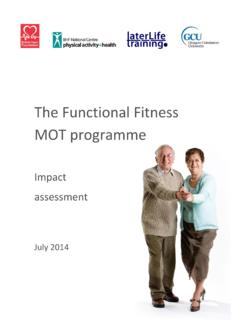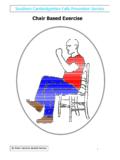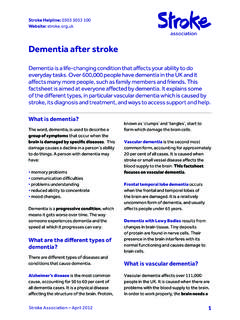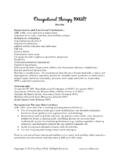Transcription of Circuit class therapy for improving mobility after …
1 Circuit class therapy for improving mobility after stroke (Review). English C, Hillier SL. This is a reprint of a Cochrane review, prepared and maintained by The Cochrane Collaboration and published in The Cochrane Library 2010, Issue 7. Circuit class therapy for improving mobility after stroke (Review). Copyright 2010 The Cochrane Collaboration. Published by John Wiley & Sons, Ltd. TABLE OF CONTENTS. HEADER .. 1. ABSTRACT .. 1. PLAIN LANGUAGE SUMMARY .. 2. BACKGROUND .. 2. OBJECTIVES .. 3. METHODS .. 3. RESULTS.
2 6. Figure 1.. 7. Figure 2.. 8. DISCUSSION .. 9. AUTHORS' CONCLUSIONS .. 11. ACKNOWLEDGEMENTS .. 11. REFERENCES .. 11. CHARACTERISTICS OF STUDIES .. 14. DATA AND ANALYSES .. 22. Analysis Comparison 1 Circuit class therapy versus other, Outcome 1 6mWT.. 22. Analysis Comparison 1 Circuit class therapy versus other, Outcome 2 Gait speed.. 23. Analysis Comparison 1 Circuit class therapy versus other, Outcome 3 Step Test.. 23. Analysis Comparison 1 Circuit class therapy versus other, Outcome 4 Timed Up and Go.
3 24. Analysis Comparison 1 Circuit class therapy versus other, Outcome 5 Berg Balance Scale.. 24. Analysis Comparison 1 Circuit class therapy versus other, Outcome 6 Activities-specific Balance Confidence Scale. 25. Analysis Comparison 1 Circuit class therapy versus other, Outcome 7 Length of stay.. 25. Analysis Comparison 1 Circuit class therapy versus other, Outcome 8 Gait speed: sensitivity analysis.. 26. Analysis Comparison 1 Circuit class therapy versus other, Outcome 9 Berg Balance Scale: sensitivity analysis.
4 26. Analysis Comparison 1 Circuit class therapy versus other, Outcome 10 Length of stay: sensitivity analysis.. 27. APPENDICES .. 27. HISTORY .. 28. CONTRIBUTIONS OF AUTHORS .. 28. DECLARATIONS OF INTEREST .. 28. SOURCES OF SUPPORT .. 28. DIFFERENCES BETWEEN PROTOCOL AND REVIEW .. 29. Circuit class therapy for improving mobility after stroke (Review) i Copyright 2010 The Cochrane Collaboration. Published by John Wiley & Sons, Ltd. [Intervention Review]. Circuit class therapy for improving mobility after stroke Coralie English1 , Susan L Hillier1.
5 1 Centre for Allied Health Evidence, University of South Australia (City East), Adelaide, Australia Contact address: Susan L Hillier, Centre for Allied Health Evidence, University of South Australia (City East), North Terrace, Adelaide, SA, 5000, Australia. Editorial group: Cochrane stroke Group. Publication status and date: New, published in Issue 7, 2010. Review content assessed as up-to-date: 21 October 2009. Citation: English C, Hillier SL. Circuit class therapy for improving mobility after stroke . Cochrane Database of Systematic Reviews 2010, Issue 7.
6 Art. No.: CD007513. DOI: Copyright 2010 The Cochrane Collaboration. Published by John Wiley & Sons, Ltd. ABSTRACT. Background Circuit class therapy (CCT) offers a supervised group forum for people after stroke to practise tasks, enabling increased practise time without increasing staffing. Objectives To examine the effectiveness and safety of CCT on mobility in adults with stroke . Search strategy We searched the Cochrane stroke Group Trials Register (last searched October 2009), the Cochrane Central Register of Controlled Trials (CENTRAL) (The Cochrane Library, Issue 2, 2009), MEDLINE (1950 to November 2008), EMBASE (1980 to November 2008), CINAHL (1982 to November 2008) and 14 other electronic databases (to November 2008).
7 We also searched proceedings from relevant conferences, reference lists and unpublished theses; contacted authors of published trials and other experts in the field;. and searched relevant clinical trials and research registers. Selection criteria Randomised or quasi-randomised controlled trials including people over 18 years old diagnosed with stroke of any severity, at any stage, or in any setting, receiving CCT. Data collection and analysis Two review authors independently selected trials for inclusion, assessed methodological quality and extracted data.
8 Main results We included six trials involving 292 participants. Participants were long-term stroke survivors living in the community or receiving inpatient rehabilitation. All could walk 10 metres with or without assistance. Four studies measured walking capacity and three measured gait speed, demonstrating that CCT was superior to the comparison intervention (Six Minute Walk Test: mean difference (MD), fixed metres, 95% confidence interval (CI) to , P < ; gait speed: MD, fixed m/s, 95% CI to , P. = 004).
9 Two studies measured balance, showing a superior effect in favour of CCT (Step Test: MD, fixed steps, 95% CI to , P = ; activities-specific balance and confidence: MD, fixed , 95% CI to , P = ). Studies also measured other balance items showing no difference in effect. Length of stay (two studies) showed a significant effect in favour of CCT (MD, fixed days, 95% CI to , P = ). Only two studies measured adverse events (falls during therapy ): all were minor. Circuit class therapy for improving mobility after stroke (Review) 1.
10 Copyright 2010 The Cochrane Collaboration. Published by John Wiley & Sons, Ltd. Authors' conclusions CCT is safe and effective in improving mobility for people after moderate stroke and may reduce inpatient length of stay. Further research is required, investigating quality of life, participation and cost-benefits, that compares CCT to standard care and that also investigates the differential effects of stroke severity, latency and age. PLAIN LANGUAGE SUMMARY. Circuit class therapy for improving mobility after stroke stroke is a major cause of increased dependence for survivors in many activities of daily life, including the ability to walk and negotiate our usual environments.









